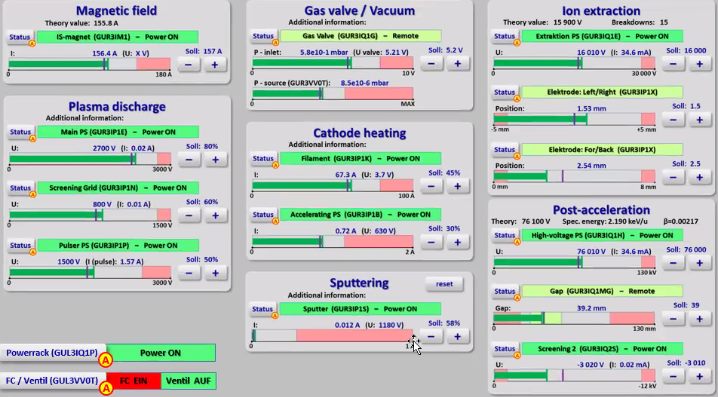Impressions about 'Meeting about Ionsource Roadmap' on December, 03rd 2020
Christian Hillbricht <c.hillbricht@gsi.de>, Martin Stein <m.stein@gsi.de> v0.1, December, 4th 2020 Present: Aleksey Adonin, Christian Hillbricht, Martin Stein, Gleb VorobyevGeneral focus of the meeting
Purpose of the meeting was to get a common idea about the expected development state of the new Ionsource Application in the beginning and during the 2021 GSI beamtime.Functions expected to work for α/β-versions of Ionsource App
Before the meeting Aleksey supplied a list of requirements very close to the following table. After discussing the question if really 'everything' in the list is needed, Aleksey underlined that for him all points of the list have equal and highest priority. (Martin: My interpretation is, that Aleksey wants as starting level an application, which can completely control an ion source without the need of the old Fortran or Swing application on the side). The following table is ordered by Martin (proposal), the ordering and prioritisation is not a result of the meeting. See above!| Name | Description | Priority |
|---|---|---|
| Basic Infos | Information about: date and time, element, ion charge state, installed ion source, Ionsource/Unilac timing, Unilac virt. acc | mandatory |
| Instruments | Functionality of all instruments for Unilac and Cryring sources as for the Swing-app: on/off, +/-, slider, direct input, info about interlocks, reset | mandatory |
| Current-Pressure/Time Plots | Current-time-plot(pressure-time-plot) displaying | mandatory |
| Increment of Set Values | Possibility to change “increment” (step width for set-values) | mandatory |
| Special functions | Functionality of the following options: auto-extraction, auto-RF, vacuum interlock, RF-coupling | necessary |
| Expert Mode Functions | Expert mode: basic functions: show/hide PS, on/off options for auto-extraction, auto-RF, vacuum interlock,… | necessary |
| Oscilloscope Signals | Displaying of oscilloscope signals with activation of web-control | necessary |
| Cathodes Controls | Information about operation time and deposited energy for Cathodes (VARIS) | necessary |
| In-Application Print Function | “printscreen”-button and function | necessary |
Time table of α/β versions testing (milestones) and targeted ion source types
-
It was mutually agreed on putting the focus on the Cryring with first α-version (milestone) of the Ionsource App.
-
Aleksey motivates to target the Unilac with the tests three (3?) weeks after the start of the α-version tests on the Cryring. Primarily the test should be focusing on the Penning ion source. See next paragraph.
Testing environment for Unilac Ion Source Testing of α/β versions (milestones)
-
Aleksey underlines that the Penning ion sources, usually working on Terminal South are the most suitable one for testing because of various reasons:
-
The Penning ion sources usually are the ion source with the most 'running-hours ' of all ion source types.
-
The Penning ion sources have time frames where small tests could be done during user beam time without interfering to much with user operation. Other ion source types are more sensitive and variation or tests are not acceptable during user beam time.
-
The Penning ion source type and/or its devices can be prepared for testing outside, in front or after user beam times in an easy way.
-
The Penning ion source type has the largest user (operator) group, persons who could be consulted before, during and after testing.
-
-
Aleksey will check for time frames for tests on the Penning ion source independently of α/β versions or milestones.
-
The Penning ion source covers nearly all functional requirements of all ion source types and thus offers a large test bed.
Layout related discussion points
Highly configurable dashboard layout vs fixed (per ion source type) dashboard layout
Aleksey and Gleb like the idea of a highly configurable dashboard layouts and following ideas in particular where discussed:-
Freely positionable instruments, data/time plots and other views like on a blackboard.
-
Freely scaleable, instruments, data/time plots and other views to optimize the available space on the screen.
-
(Expert-)User can save the layout for later reuse.
Grouped and optimized instruments layouts
Aleksey presented an interesting form of laying out instruments in groups (or grouping boxes). Those groups are a form of abstraction/presentation of physical parameters of ion sources instead of only putting into focus the instruments of the involved devices. Additionally the grouped instruments are reduced to only show view elements which are really needed for the particular instrument. This approach makes the ion source easier to understand and control and also reduces the amount of space in total needed on the dashboard. Check the image to get an impression.
Unsorted list of discussion points
-
Reset buttons will disappear from instrument main view except of rare cases. Gleb dislikes Reset buttons entirely because of the risk of misinterpretation of underlying functions.



